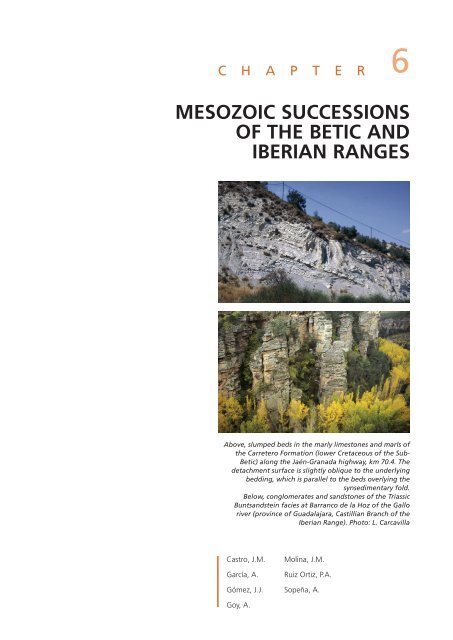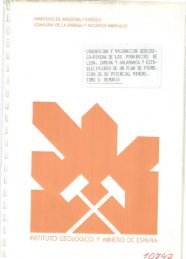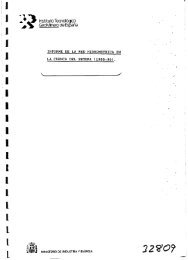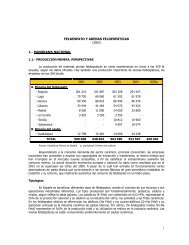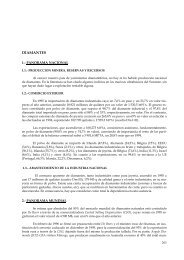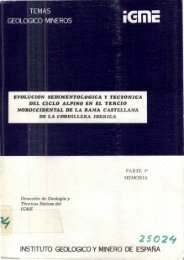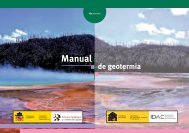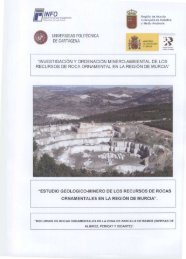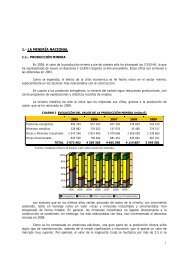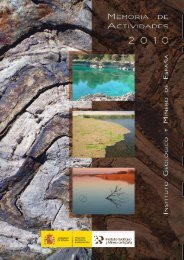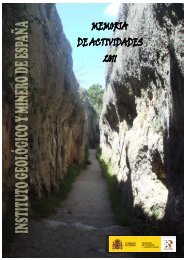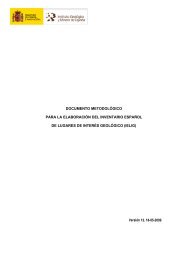mesozoic successions of the betic and iberian ranges - Instituto ...
mesozoic successions of the betic and iberian ranges - Instituto ...
mesozoic successions of the betic and iberian ranges - Instituto ...
You also want an ePaper? Increase the reach of your titles
YUMPU automatically turns print PDFs into web optimized ePapers that Google loves.
C H A P T E R 6<br />
MESOZOIC SUCCESSIONS<br />
OF THE BETIC AND<br />
IBERIAN RANGES<br />
Above, slumped beds in <strong>the</strong> marly limestones <strong>and</strong> marls <strong>of</strong><br />
<strong>the</strong> Carretero Formation (lower Cretaceous <strong>of</strong> <strong>the</strong> Sub-<br />
Betic) along <strong>the</strong> Jaén-Granada highway, km 70.4. The<br />
detachment surface is slightly oblique to <strong>the</strong> underlying<br />
bedding, which is parallel to <strong>the</strong> beds overlying <strong>the</strong><br />
synsedimentary fold.<br />
Below, conglomerates <strong>and</strong> s<strong>and</strong>stones <strong>of</strong> <strong>the</strong> Triassic<br />
Bunts<strong>and</strong>stein facies at Barranco de la Hoz <strong>of</strong> <strong>the</strong> Gallo<br />
river (province <strong>of</strong> Guadalajara, Castillian Branch <strong>of</strong> <strong>the</strong><br />
Iberian Range). Photo: L. Carcavilla<br />
Castro, J.M.<br />
García, A.<br />
Gómez, J.J.<br />
Molina, J.M.<br />
Ruiz Ortiz, P.A.<br />
Sopeña, A.<br />
Goy, A.
The Betic <strong>and</strong> Iberian Mountain Ranges display outcrops<br />
<strong>of</strong> Mesozoic rocks <strong>of</strong> great quality <strong>and</strong> continuity,<br />
<strong>and</strong> with abundant fossil remains, which have allowed<br />
to describe detailed stratigraphic series, with facies<br />
interpretation, sequence stratigraphic analysis, dating<br />
<strong>of</strong> rocks, <strong>and</strong> <strong>the</strong> definition <strong>of</strong> litho-, bio- <strong>and</strong> chronostratigraphic<br />
units with regional <strong>and</strong> even global<br />
relevance. These rocks record <strong>the</strong> geological processes<br />
<strong>and</strong> biological evolution which took place for 185 million<br />
years, <strong>the</strong> duration <strong>of</strong> <strong>the</strong> Mesozoic Era.<br />
Some <strong>of</strong> <strong>the</strong> existing facies <strong>and</strong> <strong>of</strong> <strong>the</strong> depositional<br />
models described to interpret <strong>the</strong>ir origin are spectacular<br />
examples, in some cases unique in <strong>the</strong> world.<br />
The biozonations proposed based on <strong>the</strong> study <strong>of</strong><br />
Mesozoic fossil groups from <strong>the</strong> Betic <strong>and</strong> Iberian<br />
Mountain Ranges (ammonites, benthic foraminifera,<br />
planktonic foraminifera, nanoplankton, etc.) are useful<br />
references throughout <strong>the</strong> Tethys region <strong>and</strong>, quite<br />
frequently, <strong>the</strong>y are significant examples <strong>of</strong> global<br />
scale correlation between fossil groups.<br />
In <strong>the</strong> sou<strong>the</strong>astern margin <strong>of</strong> <strong>the</strong> Iberian Massif,<br />
<strong>the</strong> westernmost exposure <strong>of</strong> <strong>the</strong> European Variscan<br />
Orogen, <strong>the</strong>re are two big units corresponding to<br />
<strong>the</strong> Alpine Ranges (Figure 1): <strong>the</strong> Betic Mountain<br />
Range, in <strong>the</strong> sou<strong>the</strong>rn Iberian Plate, <strong>and</strong> <strong>the</strong> Iberian<br />
Mountain Range east <strong>of</strong> <strong>the</strong> Iberian Massif.<br />
THE BETIC MOUNTAIN RANGE<br />
As a geological <strong>and</strong> topographic unit, <strong>the</strong> Betic<br />
Mountain Range comprises <strong>the</strong> mountain reliefs south<br />
<strong>of</strong> <strong>the</strong> Guadalquivir river, <strong>and</strong> <strong>the</strong>ir nor<strong>the</strong>ast extention<br />
into Albacete, Murcia <strong>and</strong> south <strong>of</strong> Valencia. It<br />
is located between <strong>the</strong> Iberian Massif <strong>and</strong> <strong>the</strong> Iberian<br />
Mountain range to <strong>the</strong> north, <strong>and</strong> <strong>the</strong> Atlantic <strong>and</strong><br />
Mediterranean coastlines to <strong>the</strong> south, although<br />
it actually continues under <strong>the</strong> sea connecting with<br />
o<strong>the</strong>r Alpine domains: <strong>the</strong> north African rif, <strong>and</strong><br />
<strong>the</strong> Balearic Isl<strong>and</strong>s. Hence, all <strong>the</strong> substrate <strong>of</strong> <strong>the</strong><br />
Alborán Sea, most <strong>of</strong> <strong>the</strong> Cadiz Gulf substrate, <strong>and</strong><br />
part <strong>of</strong> <strong>the</strong> Mediterranean sea bottom between <strong>the</strong><br />
coasts <strong>of</strong> Valencia <strong>and</strong> Murcia, as well as <strong>the</strong> isl<strong>and</strong>s<br />
should be considered as submerged areas <strong>of</strong> <strong>the</strong> Betic<br />
Mountain Range (Figure 1).<br />
Two great divisions <strong>of</strong> tectono-stratigraphic character<br />
are differentiated in it: <strong>the</strong> Internal Zones <strong>and</strong><br />
<strong>the</strong> External Zones (Figure 2). The Internal Zones<br />
include <strong>the</strong> highest elevations <strong>and</strong> consist <strong>of</strong> crystalline<br />
basement <strong>and</strong> sedimentary cover with a complex<br />
structure <strong>of</strong> large decollement thrusts with different<br />
tectonic units <strong>of</strong> Paleozoic <strong>and</strong> Triassic rocks. Some<br />
units also include Mesozoic <strong>and</strong> Tertiary rocks. In all<br />
cases, <strong>the</strong>se are allochthonous units belonging to <strong>the</strong><br />
Alborán subplate.<br />
The External Zones are represented by a belt <strong>of</strong><br />
sedimentary rocks forming <strong>the</strong> nor<strong>the</strong>rn sector<br />
<strong>of</strong> <strong>the</strong> mountain range. Paleogeographically, <strong>the</strong><br />
External Zones correspond to <strong>the</strong> deposits accumulated<br />
in <strong>the</strong> continental margin <strong>of</strong> <strong>the</strong> Iberian Plate<br />
Figure 1. Geological map <strong>of</strong> <strong>the</strong> western<br />
Perimediterranean Alpine Orogen (Vera, 2004).<br />
(sou<strong>the</strong>rn Iberian paleo-margin) during <strong>the</strong> Mesozoic<br />
<strong>and</strong> Tertiary. The Guadalquivir basin is found to <strong>the</strong><br />
north, filled with Neogene deposits. The Campo de<br />
Gibraltar Complex is formed by allochthonous units<br />
with Cretaceous <strong>and</strong> Tertiary mostly turbiditic deposits<br />
along <strong>the</strong> contact between <strong>the</strong> External <strong>and</strong> Internal<br />
Zones.<br />
The Mesozoic series <strong>of</strong> <strong>the</strong> Betic Mountain Range<br />
mostly crops out in <strong>the</strong> External Zones <strong>of</strong> <strong>the</strong><br />
Mountain Range, with some limited outcrops in <strong>the</strong><br />
Internal Zones <strong>and</strong> <strong>the</strong> Campo de Gibraltar Complex.<br />
Based on <strong>the</strong> Mesozoic stratigraphic record <strong>and</strong> <strong>the</strong><br />
tectonic position <strong>of</strong> <strong>the</strong> units, two great sub-divisions<br />
are usually differentiated: <strong>the</strong> Pre-Betic Zone <strong>and</strong> <strong>the</strong><br />
Sub-Betic Zone (Figure 2).<br />
The Mesozoic <strong>of</strong> <strong>the</strong> Pre-Betic Zone is essentially<br />
formed by shallow marine deposits which, to <strong>the</strong> north<br />
<strong>and</strong> northwest, transition to <strong>the</strong> forel<strong>and</strong>. From a tectonic<br />
point <strong>of</strong> view, <strong>the</strong> Pre-Betic Zone is considered<br />
<strong>the</strong> relative autochthonous to <strong>the</strong> Sub-Betic units. In<br />
<strong>the</strong> Sub-Betic Zone, <strong>the</strong> innermost tectonic units, i.e.<br />
those located inside <strong>the</strong> mountain range, are thrusted<br />
upon <strong>the</strong> most external units, <strong>and</strong> <strong>the</strong>se in turn are<br />
thrusted upon <strong>the</strong> Pre-Betic (Figure 3).<br />
The Intermediate Domain was a subsident basin<br />
adjacent to <strong>the</strong> Pre-Betic shelf since <strong>the</strong> end <strong>of</strong> <strong>the</strong><br />
Middle Jurassic, <strong>and</strong> where terrigenous <strong>and</strong> calcareous<br />
turbidites were deposited during <strong>the</strong> Late Jurassic<br />
<strong>and</strong> Early Cretaceous. The External <strong>and</strong> Internal Sub-<br />
Betic created shallower marine areas where pelagic<br />
sedimentation prevailed. The areas displaying <strong>the</strong>se<br />
features have been called pelagic thresholds (García-<br />
Hernández et al.,1988). On <strong>the</strong> contrary, <strong>the</strong> Middle<br />
Sub-Betic was a subsident area located between <strong>the</strong><br />
pelagic thresholds <strong>of</strong> <strong>the</strong> Internal <strong>and</strong> External Sub-<br />
Betic, limiting it to <strong>the</strong> north <strong>and</strong> south, where thick<br />
series <strong>of</strong> pelagic sediments were deposited.<br />
Although it has not been possible to accurately set <strong>the</strong><br />
end <strong>of</strong> <strong>the</strong> Variscan Paleozoic cycle <strong>and</strong> <strong>the</strong> beginning<br />
<strong>of</strong> <strong>the</strong> Alpine Mesozoic Cycle, in <strong>the</strong> Betic Mountain<br />
74<br />
Castro, J.M. - García, A. - Gómez, J.J. - Goy, A. - Molina, J.M. - Ruíz Ortíz, P.A. - Sopeña, A.
Figure 2. A) Paleogeographic reconstruction <strong>of</strong> <strong>the</strong> South Iberian margin in <strong>the</strong> Late Jurassic. Numbers refer to<br />
<strong>the</strong> legend.<br />
B) Geological sketch <strong>of</strong> <strong>the</strong> Betic Mountain Range.<br />
C) Section reconstructing <strong>the</strong> South Iberian margin paleogeography for <strong>the</strong> Aptian-Albian.<br />
Figure 3. Geological cross-section <strong>of</strong> <strong>the</strong> External Zones <strong>of</strong> <strong>the</strong> Betic Mountain Range across Jaén <strong>and</strong> south <strong>of</strong><br />
Córdoba province, respectively. Modified after Vera (2004).<br />
MESOZOIC SUCCESSIONS OF THE BETIC AND IBERIAN RANGES<br />
75
Range <strong>the</strong>re is no doubt about <strong>the</strong> influence <strong>of</strong> late-<br />
Variscan structures on Mesozoic sedimentation, since<br />
<strong>the</strong>y were re-activated in <strong>the</strong> subsequent extensional<br />
stage (Alpine Sedimentary Cycle). The beginning<br />
<strong>of</strong> Mesozoic sedimentation, unconformable upon<br />
Paleozoic rocks, corresponds to <strong>the</strong> classic Triassic<br />
Bunts<strong>and</strong>stein (siliciclastic sediments), Muschelkalk<br />
(carbonates) <strong>and</strong> Keuper (siliciclastic-evaporitic)<br />
German facies.<br />
On top <strong>of</strong> <strong>the</strong>se are Jurassic rocks corresponding<br />
to <strong>the</strong> carbonate sedimentation in extensive shelves<br />
protected by bioclastic bars <strong>and</strong> bioherms. The tectonic<br />
<strong>and</strong> sea level variations caused a great variety <strong>of</strong><br />
domains <strong>and</strong> facies, <strong>and</strong> <strong>the</strong> subsequent stratigraphic<br />
unconformities with plenty <strong>of</strong> hiatus as well as condensed<br />
levels, lesser in <strong>the</strong> Pre-Betic <strong>and</strong> more frequent<br />
in <strong>the</strong> External <strong>and</strong> Internal Sub-Betic (Molina,<br />
1987). In <strong>the</strong> Middle Sub-Betic, submarine volcanism<br />
brought strong bathymetric changes to <strong>the</strong> Jurassic<br />
basin, toge<strong>the</strong>r with local development <strong>of</strong> shallow<br />
carbonate shelves upon volcanic edifices considered to<br />
be guyots (Molina <strong>and</strong> Vera, 1999, 2001).<br />
At <strong>the</strong> beginning <strong>of</strong> <strong>the</strong> Cretaceous, <strong>the</strong> Pre-Betic<br />
Zone underwent <strong>the</strong> most important sedimentary<br />
stage <strong>of</strong> <strong>the</strong> Mesozoic, related to rifting processes in<br />
<strong>the</strong> North Atlantic, <strong>and</strong> determined by faults generated<br />
during this extensional period (Vilas, 2001). An<br />
important clastic input sets <strong>the</strong> beginning <strong>of</strong> <strong>the</strong> Lower<br />
Cretaceous (Figure 4). The Utrillas facies (Upper Albian)<br />
was deposited in coastal <strong>and</strong> fluvial environments,<br />
unconformably upon different Cretaceous <strong>and</strong> Jurassic<br />
units, evidently representing <strong>the</strong> post-rift deposits. The<br />
Upper Cretaceous rocks were deposited in a tectonic<br />
context which recorded <strong>the</strong> first compressive stages in<br />
<strong>the</strong> sou<strong>the</strong>rn Iberian margin, within a framework <strong>of</strong><br />
carbonate shelves. Similarly to <strong>the</strong> Jurassic sequence,<br />
<strong>the</strong> Cretaceous <strong>of</strong> <strong>the</strong> Sub-Betic Zone displays a great<br />
contrast <strong>of</strong> facies <strong>and</strong> thicknesses between <strong>the</strong> stratigraphic<br />
series <strong>of</strong> <strong>the</strong> different domains: prevailing<br />
limestone rocks <strong>and</strong> pelagic marls rich in ammonites,<br />
nanoplankton, radiolarians <strong>and</strong> foraminifera, <strong>and</strong> local<br />
interbeds <strong>of</strong> siliciclastic <strong>and</strong> carbonate turbidites. Near<br />
<strong>the</strong> Jurassic-Cretaceous boundary, <strong>the</strong>re is an unconformity<br />
recognizable throughout all <strong>the</strong> Pre-Betic, indicating<br />
a remarkable change in sedimentation.<br />
Seven places have been selected in <strong>the</strong> Betic Mountain<br />
Range based on <strong>the</strong>ir outst<strong>and</strong>ing values, which<br />
include <strong>the</strong> most interesting geological sites (geosites,<br />
Figure 5): “Cretaceous <strong>of</strong> Segura de la Sierra” <strong>and</strong><br />
“Lower Cretaceous carbonate shelves in <strong>the</strong> Jávea<br />
sector” (La Nao <strong>and</strong> San Antonio Capes, Alicante) in<br />
<strong>the</strong> Pre-Betic Zone; “Carbonate turbidites <strong>of</strong> <strong>the</strong><br />
Toril Formation” (Lower Jurassic) in <strong>the</strong> Intermediate<br />
Domain; “The “Ammonitico Rosso” facies <strong>of</strong><br />
Córdoba” <strong>and</strong> “Tectonic windows in <strong>the</strong> Sub-Betic<br />
(Carcabuey, Valdepeñas, Huelma, Cabra Santo<br />
Cristo)” in <strong>the</strong> External Sub-Betic; <strong>and</strong> “Marine<br />
volcanism <strong>and</strong> its relation to sedimentation”<br />
<strong>and</strong> “Slumps <strong>and</strong> related facies NE <strong>of</strong> Campillo<br />
de Arenas” in <strong>the</strong> Middle Sub-Betic. This selection<br />
Figure 4, above. Syn<strong>the</strong>tic paleogeographic crosssection<br />
for <strong>the</strong> Pre-Betic <strong>of</strong> <strong>the</strong> Sierra de Cazorla <strong>and</strong><br />
Segura. Pre-, syn- <strong>and</strong> post-rift stages refer to <strong>the</strong><br />
opening <strong>of</strong> <strong>the</strong> North Atlantic sea.<br />
Figure 5, below. Location <strong>of</strong> <strong>the</strong> geosites described in<br />
<strong>the</strong> text for <strong>the</strong> Betic Mountain Range:<br />
1) Segura de la Sierra.<br />
2) La Nao Cape – San Antonio Cape.<br />
3) Carbonate turbidites.<br />
4) Ammonitico rosso.<br />
5) Carcabuey, Valdepeñas, Huelma <strong>and</strong> Cabra Sto.<br />
Cristo tectonic windows.<br />
6) Volcanism <strong>and</strong> related sedimentation.<br />
7) Campillo de Arenas.<br />
76<br />
Castro, J.M. - García, A. - Gómez, J.J. - Goy, A. - Molina, J.M. - Ruíz Ortíz, P.A. - Sopeña, A.
Figure 7, above. Segura de la Sierra castle, built on <strong>the</strong><br />
Cenomanian Dolomitic Formation. The s<strong>and</strong>s <strong>of</strong> <strong>the</strong><br />
Albian Utrillas Formation crop out in <strong>the</strong> lower part.<br />
Figure 6, left. The Yelmo as seen from Segura de la<br />
Sierra. The view shows <strong>the</strong> eastern flank <strong>of</strong> <strong>the</strong> syncline<br />
formed by a s<strong>and</strong>y succession <strong>of</strong> <strong>the</strong> Utrillas Formation<br />
(late Albian), overlain by <strong>the</strong> Dolomitic Formation<br />
(Cenomanian) <strong>and</strong> <strong>the</strong> Utiel Limestone Formation<br />
(Coniacian-Senonian).<br />
provides <strong>the</strong> record <strong>of</strong> some <strong>of</strong> <strong>the</strong> main geological<br />
processes active in <strong>the</strong> different areas <strong>of</strong> <strong>the</strong> Betic<br />
Mountain Range during <strong>the</strong> Mesozoic.<br />
The Cretaceous <strong>of</strong> Segura de la Sierra (Orcera, Jaén)<br />
is one <strong>of</strong> <strong>the</strong> stratigraphic sections <strong>of</strong> <strong>the</strong> External<br />
Pre-Betic (Segura de la Sierra-Madera river Sector)<br />
with a great variety <strong>of</strong> facies <strong>and</strong> excellent quality <strong>of</strong><br />
outcrops. It is a privileged site to observe, in just a few<br />
kilometers, <strong>the</strong> stratigraphic record <strong>of</strong> <strong>the</strong> External<br />
Pre-Betic (where most <strong>of</strong> <strong>the</strong> Lower Cretaceous does<br />
not outcrop <strong>and</strong> <strong>the</strong> Upper Albian Utrillas facies rest<br />
upon Jurassic units) to <strong>the</strong> Internal Pre-Betic, with a<br />
complete Lower Cretaceous sequence.<br />
The section <strong>of</strong> Arroyo de los Anchos was used to define<br />
<strong>the</strong> formation with <strong>the</strong> same name, originally comprising<br />
<strong>the</strong> whole interval between <strong>the</strong> Neocomian <strong>and</strong><br />
<strong>the</strong> Utrillas facies. The panoramic views <strong>of</strong> El Yelmo<br />
<strong>and</strong> <strong>the</strong> surroundings <strong>of</strong> Segura de la Sierra, as seen<br />
from <strong>the</strong> viewpoint in <strong>the</strong> outskirts <strong>of</strong> this town, have<br />
a very high educational value. El Yelmo Section (Figure<br />
6) shows a conspicuous syncline structure with several<br />
Lower Cretaceous units laterally thinning out to<br />
<strong>the</strong> west in a very short distance. The view towards<br />
<strong>the</strong> nor<strong>the</strong>ast shows a panoramic <strong>of</strong> <strong>the</strong> Segura de la<br />
Sierra Section, typical <strong>of</strong> <strong>the</strong> External Pre-Betic, with<br />
a stratigraphic hiatus comprising most <strong>of</strong> <strong>the</strong> Lower<br />
Cretaceous (Figure 7).<br />
This area is part <strong>of</strong> <strong>the</strong> Cazorla, Segura <strong>and</strong> Las Villas<br />
Natural Park, where <strong>the</strong> Madera river has its source,<br />
<strong>and</strong> an area <strong>of</strong> beautiful l<strong>and</strong>scapes, with abundant<br />
vegetation <strong>and</strong> big game. Segura de la Sierra was <strong>the</strong><br />
retreat place <strong>of</strong> <strong>the</strong> Spanish poet Jorge Manrique, <strong>and</strong><br />
is a picturesque town rich in historical monuments.<br />
MESOZOIC SUCCESSIONS OF THE BETIC AND IBERIAN RANGES 77
Figure 8, right. Sierra de Seguilí: Urgonian facies<br />
with corals, rudists <strong>and</strong> ostreids. Aptian Llopis<br />
Formation.<br />
Figure 9, below. Sierra de Peñón, panoramic view<br />
<strong>of</strong> <strong>the</strong> syncline. The succession cropping out in <strong>the</strong><br />
fold is <strong>the</strong> Albian Jumilla Formation <strong>and</strong> <strong>the</strong><br />
Cenomanian Jaén Limestone Formation.<br />
Figure 10, right. Upper Jurassic carbonate turbidites in<br />
<strong>the</strong> Jabalcuz-San Cristobal Unit, organized in thinning<br />
sequences resulting from filling <strong>and</strong> ab<strong>and</strong>onment <strong>of</strong><br />
submarine channels.<br />
The exposures <strong>of</strong> <strong>the</strong> Pre-Betic in <strong>the</strong> Jávea sector<br />
(Alicante) between La Nao Cape <strong>and</strong> San Antonio<br />
Cape, show a continuous stratigraphic record <strong>of</strong> <strong>the</strong><br />
Aptian to Middle Cenomanian interval, in shallow<br />
marine carbonate shelf facies. The exposure has a<br />
high quality, both in detailed <strong>and</strong> panoramic scale,<br />
with abundant <strong>and</strong> varied facies, <strong>and</strong> several groups<br />
<strong>of</strong> marine fossils. The sedimentology <strong>and</strong> paleontology<br />
<strong>of</strong> <strong>the</strong> accurately dated stratigraphic sections show a<br />
record <strong>of</strong> <strong>the</strong> environmental evolution <strong>of</strong> <strong>the</strong> sou<strong>the</strong>rn<br />
Iberian plate paleocontinental margin in an exceptionally<br />
interesting time interval for Earth’s history.<br />
At <strong>the</strong> Sierra de Seguilí (Figure 8), a very complete<br />
Aptian-Lower Cenomanian section (Llopis Formation)<br />
crops out with Urgonian facies (corals, rudists, ostreids).<br />
Sierra del Peñón displays a spectacular syncline<br />
structure (Figure 9) with a succession formed by<br />
limestone with rudists <strong>of</strong> <strong>the</strong> Upper Albian Jumilla<br />
Formation, <strong>and</strong> limestone with calcispheres <strong>and</strong> big<br />
flat orbitolines <strong>of</strong> <strong>the</strong> Cenomanian Jaén Formation,<br />
with a total average thickness <strong>of</strong> 700 m.<br />
The stratigraphic type section for <strong>the</strong> Mesozoic in<br />
<strong>the</strong> Intermediate Domain crops out in <strong>the</strong> Jabalcuz<br />
Sector along <strong>the</strong> road Jaén-Los Villares, with <strong>the</strong><br />
Dogger (Jurassic) through Cenomanian (Cretaceous)<br />
record represented by <strong>the</strong> holostratotypes <strong>of</strong> <strong>the</strong> Toril,<br />
Los Villares, Cerrajón <strong>and</strong> Puerto Viejo formations. It<br />
is a Jurassic-Cretaceous sequence more than 4000 m<br />
thick, which makes it one <strong>of</strong> <strong>the</strong> thickest for all <strong>the</strong><br />
Mesozoic <strong>of</strong> <strong>the</strong> Betic Mountain Ranges. The carbonate<br />
turbidite series <strong>of</strong> <strong>the</strong> Toril Formation (Upper<br />
Jurassic) crops out along <strong>the</strong> road Jaén-Los Villares<br />
(Figures 10 <strong>and</strong> 11) a few kilometers from Jaén, <strong>and</strong><br />
is considered one <strong>of</strong> <strong>the</strong> best examples <strong>of</strong> carbonate<br />
turbidites in <strong>the</strong> world (Tucker <strong>and</strong> Wright, 1990).<br />
Carbonate turbidites are relatively frequent in <strong>the</strong><br />
Jurassic record <strong>and</strong> <strong>the</strong>y come from shelf margin <strong>and</strong><br />
78<br />
Castro, J.M. - García, A. - Gómez, J.J. - Goy, A. - Molina, J.M. - Ruíz Ortíz, P.A. - Sopeña, A.
Figure 11, above left. Calcarenite, carbonate turbidite<br />
with Bouma T b-d<br />
sequence. Level c shows ripples with<br />
convolute lamination. East <strong>of</strong> Jabalcuz, Jaén-Los<br />
Villares road.<br />
Figure 12, above right. Lower part <strong>of</strong> <strong>the</strong> Jurassic<br />
Ammonitico Rosso facies succession at <strong>the</strong> Cañada del<br />
Hornillo, Gaena Unit, Sierra de Gaena (Córdoba).<br />
Figure 13, left. Exposure <strong>of</strong> <strong>the</strong> Upper Ammonitico<br />
Rosso Formation at Fuente de Los Frailes, in <strong>the</strong> South<br />
Betic unit <strong>of</strong> Camarena-Lanchares. Upper surface <strong>of</strong> a<br />
bed with abundant ammonites.<br />
slope carbonate sediments. The exposures included<br />
in this geosite (Road Jaén-Los Villares) show one <strong>of</strong><br />
<strong>the</strong> scarce submarine fan models in calcareous turbidites<br />
described in geological literature: a channeldyke<br />
complex (Cabra del Santo Cristo) <strong>and</strong> an apron<br />
model (non-channeled lens deposit, located at <strong>the</strong><br />
base <strong>of</strong> <strong>the</strong> submarine slope) (Sierra de Huelma), that<br />
is to say, three different carbonate turbidite models<br />
in nearby exposures <strong>and</strong> within <strong>the</strong> same geological<br />
framework.<br />
One <strong>of</strong> <strong>the</strong> most interesting facies <strong>of</strong> <strong>the</strong> Mesozoic<br />
series in <strong>the</strong> Alpine mountain <strong>ranges</strong>, from a paleontological,<br />
stratigraphic <strong>and</strong> sedimentological point <strong>of</strong><br />
view, is <strong>the</strong> Ammonitico Rosso facies, with magnificent<br />
exposures in <strong>the</strong> Sierras Subbéticas Natural Park.<br />
The Sub-Betic Domain is an exceptional representative<br />
to begin studying <strong>the</strong> geology in <strong>the</strong> core <strong>of</strong> <strong>the</strong><br />
Betic Mountain Range, <strong>and</strong> within <strong>the</strong> wide geodiversity<br />
<strong>of</strong> <strong>the</strong> protected areas <strong>of</strong> Andalucía.<br />
The Ammonitico Rosso facies are pelagic nodular<br />
limestones <strong>and</strong> marly limestones with a prevailing red<br />
color (Figure 12), with abundant ammonites (Figure<br />
13). They represent time intervals with a very low sedimentation<br />
rate, with ages between Bajocian (Middle<br />
Jurassic) <strong>and</strong> Berriasian (Early Cretaceous). The ammonites<br />
are <strong>of</strong> great paleontological <strong>and</strong> biostratigraphic<br />
interest. They represent cosmopolitan species with a<br />
wide geographical distribution in world seas during<br />
<strong>the</strong> Jurassic <strong>and</strong> <strong>the</strong> Cretaceous, <strong>and</strong> which evolved<br />
very fast leading to a great number <strong>of</strong> species. They<br />
are, <strong>the</strong>refore, excellent biostratigraphic guide fossils<br />
<strong>and</strong> very good paleogeographic <strong>and</strong> paleoenvironmental<br />
indicators.<br />
In <strong>the</strong> Sub-Betic <strong>of</strong> Córdoba <strong>the</strong>re are several stratigraphic<br />
sections with magnificent exposures (Fuente<br />
de los Frailes, Cañada del Hornillo, Puerto Escaño, <strong>and</strong><br />
Cortijo de Veleta), known worldwide for <strong>the</strong> study <strong>of</strong><br />
ammonite evolution, <strong>and</strong> <strong>of</strong> <strong>the</strong> evolution <strong>of</strong> <strong>the</strong> Betic<br />
Mountain Range itself. These sections have allowed to<br />
establish very accurate biostratigraphic dating <strong>of</strong> <strong>the</strong><br />
Middle-Upper Jurassic <strong>and</strong> <strong>the</strong> limit with <strong>the</strong> Lower<br />
Cretaceous.<br />
Very near Fuente de los Frailes is <strong>the</strong> Ermita de<br />
Nuestra Señora de la Sierra, located in <strong>the</strong> Picacho<br />
de la Sierra de Cabra, a spot known as “<strong>the</strong> Balcony<br />
<strong>of</strong> Andalusia“ due to <strong>the</strong> spectacular scenery covering<br />
geographical, geological <strong>and</strong> l<strong>and</strong>scape features.<br />
The view includes <strong>the</strong> three great geological domains<br />
<strong>of</strong> Andalucía: Sierra Morena, <strong>the</strong> Guadalquivir river<br />
depression, <strong>and</strong> <strong>the</strong> Betic Mountain Range. It is so<br />
MESOZOIC SUCCESSIONS OF THE BETIC AND IBERIAN RANGES 79
Figure 14, above left. Valdepeñas de Jaén tectonic<br />
window. The carbonate reliefs <strong>of</strong> <strong>the</strong> South Betic<br />
Jurassic <strong>of</strong> La P<strong>and</strong>era (to <strong>the</strong> left) <strong>and</strong> <strong>of</strong> El<br />
Ventisquero (to <strong>the</strong> right) confine <strong>the</strong> exposures <strong>of</strong><br />
<strong>the</strong> Cretaceous Intermediate Domain found along <strong>the</strong><br />
valley.<br />
Figure 15, above right. Detail <strong>of</strong> <strong>the</strong> pillow lavas in <strong>the</strong><br />
Barranco de los Lobos, sou<strong>the</strong>ast <strong>of</strong> Huelma (Jaén).<br />
Figure 16, right. Jurassic guyot <strong>of</strong> <strong>the</strong> Cortijo de<br />
Almendralejo (Granada).<br />
impressive that, following a proposal from <strong>the</strong> XIV<br />
International Geological Congress (Madrid, 1926),<br />
it was declared “Sitio de Interés Natural” (Site <strong>of</strong><br />
Natural Interest).<br />
In <strong>the</strong> central sector <strong>of</strong> <strong>the</strong> Betic Ranges, <strong>the</strong> structure<br />
<strong>of</strong> large thrusted blocks is particularly evident thanks<br />
to <strong>the</strong> outcrops <strong>of</strong> underlying rocks, which are surrounded<br />
by overthrusted units, forming <strong>the</strong> so-called<br />
“tectonic windows”. These allow to identify <strong>and</strong><br />
study <strong>the</strong> tectonic thrusting <strong>of</strong> enormous masses set in<br />
motion by <strong>the</strong> existence <strong>of</strong> a plastic level, in this case<br />
<strong>the</strong> red Triassic clays, which behaved as a detachment<br />
level <strong>of</strong> <strong>the</strong> Mesozoic series over <strong>the</strong> Paleozoic basement.<br />
The best examples <strong>of</strong> tectonic windows are in<br />
<strong>the</strong> Sub-Betic <strong>of</strong> Jaén, occupying a very similar relative<br />
position, some kilometers south <strong>of</strong> <strong>the</strong> Sub-Betic<br />
thrust front. In <strong>the</strong> cases explained herein, <strong>the</strong>re are<br />
rocks <strong>of</strong> <strong>the</strong> Intermediate Domain.<br />
In <strong>the</strong>se exposures it is possible to observe <strong>the</strong> lower<br />
resistance to erosion <strong>of</strong> <strong>the</strong> Cretaceous rocks, which<br />
crop out widely in <strong>the</strong> tectonic windows, compared to<br />
<strong>the</strong> higher resistance <strong>of</strong> <strong>the</strong> Jurassic rocks overlapping<br />
<strong>the</strong>m. At <strong>the</strong> base <strong>of</strong> <strong>the</strong> Jurassic, it is common to find<br />
a bed <strong>of</strong> red Triassic gypsum-rich clays which acted as<br />
a detachment level <strong>of</strong> <strong>the</strong> Mesozoic series, <strong>and</strong> facilitated<br />
<strong>the</strong> sliding.<br />
In <strong>the</strong> case <strong>of</strong> <strong>the</strong> tectonic window in Valdepeñas<br />
de Jaén (road from Jaén to Valdepeñas de Jaén), it<br />
is possible to observe most <strong>of</strong> <strong>the</strong> tectonic window<br />
<strong>and</strong> <strong>the</strong> thrusted front surrounding it in a single outlook<br />
(Figure 14). Upper Jurassic-Berriasian carbonate<br />
turbidites crop out in <strong>the</strong> tectonic windows <strong>of</strong><br />
Huelma <strong>and</strong> Cabra del Santo Cristo. In <strong>the</strong> tectonic<br />
window <strong>of</strong> Huelma, Ruiz-Ortiz et al. (2001) have<br />
described <strong>the</strong> first known example <strong>of</strong> fossil submarine<br />
canyon in <strong>the</strong> South Iberian paleomargin. These<br />
magnificent examples are located in <strong>the</strong> province<br />
<strong>of</strong> Jaén, <strong>and</strong> in all cases just a few kilometers away<br />
from <strong>the</strong> capital.<br />
During <strong>the</strong> Middle-Late Jurassic, in wide sectors <strong>of</strong><br />
<strong>the</strong> South Iberian continental margin with pelagic<br />
sedimentation (Middle Sub-Betic), <strong>the</strong>re was submarine<br />
volcanic activity <strong>of</strong> basaltic composition,<br />
creating elevations in <strong>the</strong> sea bottom which controlled<br />
most <strong>of</strong> <strong>the</strong> sedimentation. The most typical<br />
structures <strong>of</strong> <strong>the</strong> volcanic marine effusions are pillow<br />
lavas, among which <strong>the</strong>re may be sediments in different<br />
proportions, with different kinds <strong>of</strong> relationships<br />
between <strong>the</strong> marine pelagic sediments <strong>and</strong><br />
<strong>the</strong> volcanic rock.<br />
In <strong>the</strong> Middle Sub-Betic, in <strong>the</strong> provinces <strong>of</strong> Jaén<br />
<strong>and</strong> Granada, <strong>the</strong>re are very good examples <strong>of</strong><br />
Upper Jurassic stratigraphic series exposing <strong>the</strong> different<br />
relationships between marine volcanism <strong>and</strong><br />
pelagic sedimentation. At <strong>the</strong> Barranco de los Lobos<br />
(Huelma, Jaén), <strong>the</strong> morphology <strong>of</strong> <strong>the</strong>se submarine<br />
volcanic structures can be seen with cross sections<br />
showing ovoid or sphere shapes, although <strong>the</strong>y really<br />
correspond to cylindrical pipes, more or less continuous,<br />
branched <strong>and</strong>/or deformed (Figure 15).<br />
Lava flows formed local accumulations as big volcanic<br />
edifices. Shallow carbonate shelves developed<br />
80<br />
Castro, J.M. - García, A. - Gómez, J.J. - Goy, A. - Molina, J.M. - Ruíz Ortíz, P.A. - Sopeña, A.
Figure 17. Slump in <strong>the</strong> Lower<br />
Cretaceous Carretero Formation, along<br />
<strong>the</strong> Jaén-Granada motorway, km 60.9.<br />
The synsedimentary folds are bound<br />
by beds unaffected by <strong>the</strong> submarine<br />
sliding (<strong>the</strong> lower ones) or deposited<br />
immediately after (<strong>the</strong> upper ones).<br />
atop some <strong>of</strong> <strong>the</strong>se edifices, isolated in <strong>the</strong> middle <strong>of</strong><br />
<strong>the</strong> ocean as guyots. They were formed in a very special<br />
geodynamical context <strong>of</strong> a passive continental<br />
margin, where volcanic activity had a great influence,<br />
basically controlling <strong>the</strong> distribution <strong>of</strong> sedimentary<br />
facies throughout <strong>the</strong> Middle-Upper Jurassic. In <strong>the</strong><br />
Cortijo de Almendralejo (Granada), a relief caused<br />
by <strong>the</strong> accumulation <strong>of</strong> submarine volcanic lavas can<br />
be observed, so that <strong>the</strong> summit was not very deep<br />
under <strong>the</strong> sea level, favoring <strong>the</strong> development <strong>of</strong> an<br />
isolated marine shelf in <strong>the</strong> Tethys ocean during <strong>the</strong><br />
Jurassic (Figure 16).<br />
The stratigraphic sections <strong>and</strong> <strong>the</strong> aforementioned<br />
volcanic exposures with pillow lavas interbedded<br />
within pelagic facies <strong>and</strong> guyots locally developed<br />
on top <strong>of</strong> a shallow carbonate shelf, are <strong>the</strong> only<br />
examples <strong>of</strong> fossil Jurassic guyots described in <strong>the</strong><br />
Alpine mountain <strong>ranges</strong>, an exceptional fact which<br />
emphasizes <strong>the</strong> relevance <strong>of</strong> <strong>the</strong>se outcrops (Vera et<br />
aI., 1997).<br />
The Middle Sub-Betic also presents unique exposures<br />
with abundant synsedimentary deformation<br />
structures (slumps) as well as intraformational breccias.<br />
Slumps at Campillo de Arenas (Jaén) are truly<br />
exceptional due to <strong>the</strong> clarity with which <strong>the</strong> most<br />
outst<strong>and</strong>ing features <strong>of</strong> <strong>the</strong>se synsedimentary structures<br />
can be seen, originated around 125 million<br />
years ago in <strong>the</strong> Early Cretaceous (Barremian).<br />
Along <strong>the</strong> highway from Jaén to Granada <strong>the</strong>re are<br />
splendid examples <strong>of</strong> slumps <strong>and</strong> synsedimentary<br />
folds. Their genesis is related to submarine l<strong>and</strong>slide<br />
<strong>of</strong> materials. At <strong>the</strong> Km 70.4 <strong>of</strong> <strong>the</strong> highway, <strong>the</strong> base<br />
<strong>of</strong> <strong>the</strong> slump lays unconformable on <strong>the</strong> underlying<br />
beds, representing a submarine erosional surface<br />
(slump scar), so that <strong>the</strong> slided <strong>and</strong> deformed beds<br />
from higher upslope areas were scattered on top <strong>of</strong><br />
it. Overall, <strong>the</strong> scar defines a big concave surface,<br />
which was filled by <strong>the</strong> slided <strong>and</strong> deformed units on<br />
top <strong>of</strong> it. Thus, this surface was for some time <strong>the</strong><br />
sea bottom.<br />
Down slope sliding means <strong>the</strong> progressive increase <strong>of</strong><br />
deformation, to <strong>the</strong> point when <strong>the</strong> deformed beds<br />
dislodge into pieces <strong>and</strong> <strong>the</strong> sliding sedimentary package<br />
is fully made up by disrupted beds, immersed in<br />
a more heterogeneous <strong>and</strong> chaotic set <strong>of</strong> marls <strong>and</strong><br />
marly limestone fragments. This kind <strong>of</strong> beds represent<br />
an intermediate stage between what is called a<br />
slump <strong>and</strong> what are considered intrafomational breccias,<br />
which would be formed by limestone or marly<br />
limestone fragments immersed in a more or less abundant<br />
marly matrix. The presence <strong>of</strong> slumps is evidence<br />
for <strong>the</strong> existence <strong>of</strong> a sedimentary environment with<br />
sufficient slope for sediments to slide down slope creating<br />
<strong>the</strong>se significant structures, with tectonic activity<br />
triggering <strong>the</strong> submarine sliding phenomena.<br />
Figure 17 <strong>and</strong> <strong>the</strong> picture introducing <strong>the</strong> chapter<br />
are spectacular examples <strong>of</strong> slumps in <strong>the</strong> Lower<br />
Cretaceous Carretero Formation, one <strong>of</strong> <strong>the</strong> most<br />
characteristic units <strong>of</strong> <strong>the</strong> Sub-Betic Zone. The stratotype<br />
is found south <strong>of</strong> Campillo de Arenas, at Puerto<br />
Carretero, along <strong>the</strong> old road from Jaén to Granada. It<br />
consists <strong>of</strong> <strong>the</strong> so-called rhythmites, a rhythmical alternation<br />
<strong>of</strong> marly limestone <strong>and</strong> pelagic marls deposited<br />
in a marine basin far from <strong>the</strong> coast line (<strong>of</strong>fshore) <strong>and</strong><br />
with a low energy. The rhythmical stratigraphic alternation<br />
between higher <strong>and</strong> lower carbon contents has<br />
a primary origin related to sedimentation following<br />
Milankovitch cycles lasting around 20,000 years for<br />
each marly limestone-marl pair. In addition, <strong>the</strong> difference<br />
in composition <strong>of</strong> <strong>the</strong> alternating beds might<br />
have later been enhanced by diagenetic processes.<br />
IBERIAN MOUNTAIN RANGE<br />
The Iberian Mountain Range is an Alpine structure<br />
stretching from <strong>the</strong> Cantabrian Mountain Range<br />
to <strong>the</strong> Mediterranean Sea. It is a chain with a thick<br />
sedimentary tegument cover, located in <strong>the</strong> forel<strong>and</strong><br />
<strong>of</strong> <strong>the</strong> Pyrenees <strong>and</strong> <strong>of</strong> <strong>the</strong> Betic Mountain Range<br />
(Sopeña <strong>and</strong> de Vicente, 2004). It has been divided<br />
lengthwise into two branches, <strong>the</strong> Aragonese Branch<br />
<strong>and</strong> <strong>the</strong> Castillian Branch (Figure 18), both separated<br />
MESOZOIC SUCCESSIONS OF THE BETIC AND IBERIAN RANGES 81
Figure 18, above. Geological scheme <strong>of</strong> <strong>the</strong> Iberian<br />
Mountain Range. CL: Catalonian Littoral Coastal<br />
Range; CP: Catalonian Pre-littoral Coastal Range; RA:<br />
Aragonese Branch <strong>of</strong> <strong>the</strong> Iberian Mountain Range; RC:<br />
Castilian Branch <strong>of</strong> <strong>the</strong> Iberian Mountain Range; SL:<br />
Levante Sector <strong>of</strong> <strong>the</strong> Iberian Mountain Range.<br />
Main faults making up <strong>the</strong> structure.<br />
Transverse cross section (I-II) <strong>of</strong> <strong>the</strong> Iberian Mountain<br />
Range (after Sopeña <strong>and</strong> De Vicente, 2004).<br />
Figure 19, right. Simplified chronogram <strong>of</strong> <strong>the</strong> late<br />
Variscan tectonic events <strong>and</strong> <strong>the</strong> beginning <strong>of</strong> <strong>the</strong><br />
Alpine cycle in <strong>the</strong> centre <strong>and</strong> west <strong>of</strong> Iberia. Modified<br />
after González-Casado et al. (1996, in Sopeña <strong>and</strong><br />
Sánchez-Moya, 2004).<br />
by <strong>the</strong> Tertiary basins <strong>of</strong> Daroca <strong>and</strong> Teruel, <strong>and</strong> joined<br />
in <strong>the</strong> Levante region. The Range is mainly formed by<br />
Permian <strong>and</strong> Mesozoic sediments laying on an angular<br />
<strong>and</strong> erosive unconformity over metamorphic Variscan<br />
basement rocks.<br />
At <strong>the</strong> end <strong>of</strong> <strong>the</strong> Variscan Orogeny, <strong>the</strong> Iberian<br />
microplate was limited by two big transcurrent fault<br />
zones, separating it from <strong>the</strong> European <strong>and</strong> African<br />
plate. The result <strong>of</strong> <strong>the</strong> relative movement between<br />
<strong>the</strong>se two big plates was <strong>the</strong> insertion <strong>of</strong> <strong>the</strong> Iberian<br />
plate in a mega-shear zone, suffering a complicated<br />
breaking process by tearing. Based on <strong>the</strong> fracture<br />
processes, intra-mountain basins are individualized in<br />
certain areas <strong>of</strong> <strong>the</strong> orogen. Breaking shows a fragile<br />
response <strong>of</strong> <strong>the</strong> crust to <strong>the</strong> continued compressive<br />
situations still related to Variscan Orogeny, <strong>and</strong> in<br />
addition <strong>the</strong>se processes were joined by a high magmatic<br />
activity, an example <strong>of</strong> which are <strong>the</strong> Upper<br />
Carboniferous – Lower Permian volcanic rocks in <strong>the</strong><br />
Castillian Branch <strong>of</strong> <strong>the</strong> Iberian Mountain Range.<br />
Many authors place <strong>the</strong> end <strong>of</strong> <strong>the</strong> late-Variscan tectonic<br />
phase around <strong>the</strong> mid Permian (Figure 19), when<br />
<strong>the</strong>re was a decrease <strong>of</strong> tectonic activity. However,<br />
according to González-Casado et al. (1996), <strong>the</strong><br />
boundary between <strong>the</strong> end <strong>of</strong> <strong>the</strong> Variscan Cycle <strong>and</strong><br />
<strong>the</strong> beginning <strong>of</strong> <strong>the</strong> Alpine Cycle has not yet been<br />
precisely set, <strong>and</strong> <strong>the</strong> Permian sedimentary record is<br />
crucial to underst<strong>and</strong> this transition.<br />
82<br />
Castro, J.M. - García, A. - Gómez, J.J. - Goy, A. - Molina, J.M. - Ruíz Ortíz, P.A. - Sopeña, A.
configuration <strong>and</strong> <strong>the</strong> relative movements <strong>of</strong> its blocks<br />
during <strong>the</strong> Mesozoic <strong>and</strong> Tertiary.<br />
The Permian <strong>of</strong> <strong>the</strong> Iberian Mountain Range lays<br />
unconformably on <strong>the</strong> Lower Paleozoic with an important<br />
paleorelief. In <strong>the</strong> central section <strong>of</strong> <strong>the</strong> Castillian<br />
Branch, <strong>the</strong> basal formation (“Capas de la Ermita”)<br />
displays a great variety <strong>of</strong> facies. Volcanoclastic rocks<br />
dominate, with frequent interbeds <strong>of</strong> conglomerate,<br />
s<strong>and</strong>stone <strong>and</strong> shale interpreted as slope deposits, <strong>and</strong><br />
small river valley deposits. The rest <strong>of</strong> <strong>the</strong> unit is made<br />
up <strong>of</strong> thin sequences <strong>of</strong> alternating shale <strong>and</strong> finegrained<br />
s<strong>and</strong>stone <strong>of</strong> lacustrine origin. The paleontological<br />
content is one <strong>of</strong> <strong>the</strong> outst<strong>and</strong>ing features <strong>of</strong><br />
this unit, thanks to <strong>the</strong> big amount <strong>of</strong> opalized wood<br />
(Figure 20) <strong>and</strong> <strong>the</strong> remains <strong>of</strong> Early Permian flora.<br />
There are also red shales with interbeds <strong>of</strong> s<strong>and</strong>stone<br />
<strong>and</strong> conglomerate, found within <strong>the</strong> Saxonian type<br />
facies (“Capas de Montesoro”), <strong>and</strong> unconformably<br />
overlaying <strong>the</strong> Paleozoic or <strong>the</strong> previous unit (“Capas<br />
de la Ermita”). Due to its stratigraphic position, its age<br />
is undoubtedly Permian, although it is not possible to<br />
be more accurate due to <strong>the</strong> absence <strong>of</strong> paleontological<br />
criteria. This sedimentary package is separated by<br />
a low-angle unconformity from Upper Permian-Lower<br />
Triassic basal conglomerates in Bunts<strong>and</strong>stein facies.<br />
Figure 20, above. Opalized wood near <strong>the</strong> base <strong>of</strong> <strong>the</strong><br />
Lower Permian at Rillo de Gallo.<br />
Figure 21, below. Location <strong>of</strong> <strong>the</strong> geosites proposed<br />
for <strong>the</strong> Mesozoic <strong>of</strong> <strong>the</strong> Iberian Mountain Range:<br />
1) Almunia-Ricla<br />
2) Señorío de Molina <strong>and</strong> Fuentelsaz<br />
3) Sierra de Gúdar<br />
4) Fuente La Puerca<br />
5) Somolinos Lake<br />
(Geological units <strong>of</strong> Spain <strong>and</strong> Portugal according<br />
to Vera et al., 2004, fig. 1.4)<br />
The evolution <strong>of</strong> this Iberian chain is a good example <strong>of</strong><br />
how late Variscan structures notably influenced <strong>the</strong> late<br />
sedimentation during <strong>the</strong> Permian <strong>and</strong> <strong>the</strong> Mesozoic<br />
(Sopeña et al., 1988). Many <strong>of</strong> <strong>the</strong> late Variscan faults<br />
were reactivated as normal faults during <strong>the</strong> following<br />
extensional stage (Alpine sedimentary cycle), or<br />
as reverse faults during tectonic inversion (Alpine<br />
Orogeny), which created <strong>the</strong> present structure <strong>of</strong> this<br />
mountain range. Thus, <strong>the</strong> main paleogeographic features<br />
<strong>of</strong> Mesozoic sedimentation, toge<strong>the</strong>r with <strong>the</strong><br />
current structural style, are a reflection <strong>of</strong> basement<br />
The Triassic sequence <strong>of</strong> <strong>the</strong> Iberian Mountain<br />
Range consists <strong>of</strong> <strong>the</strong> three classical lith<strong>of</strong>acies typical<br />
<strong>of</strong> <strong>the</strong> German Triassic: a lower siliciclastic series<br />
(Bunts<strong>and</strong>stein), a middle carbonate <strong>and</strong> evaporite<br />
series (Muschelkalk), <strong>and</strong> an upper evaporite-rich series<br />
(Keuper). In <strong>the</strong> central sector <strong>of</strong> <strong>the</strong> Castillian Branch<br />
<strong>of</strong> <strong>the</strong> Iberian Mountain Range, five Triassic formations<br />
have been defined making up <strong>the</strong> Guadalajara Group<br />
(Sopeña et aI., 1983).<br />
Among <strong>the</strong> several stratigraphic sections which record<br />
<strong>the</strong> end <strong>of</strong> <strong>the</strong> Paleozoic <strong>and</strong> <strong>the</strong> beginning <strong>of</strong> <strong>the</strong><br />
Mesozoic in <strong>the</strong> Iberian Mountain range (Figure 21),<br />
we must highlight <strong>the</strong> exposures in <strong>the</strong> headwaters<br />
<strong>and</strong> gorge <strong>of</strong> <strong>the</strong> Arroyo Viejo, in <strong>the</strong> township <strong>of</strong><br />
Rillo de Gallo, <strong>and</strong> its continuation along <strong>the</strong> Gallo<br />
river valley <strong>and</strong> <strong>the</strong> Barranco de la Hoz (Guadalajara).<br />
This section is unique in <strong>the</strong> Iberian Range <strong>and</strong> most<br />
likely also in all western Europe. It allows for detailed<br />
analysis <strong>of</strong> <strong>the</strong> geological evolution during <strong>the</strong> latest<br />
Paleozoic <strong>and</strong> <strong>the</strong> beginning <strong>of</strong> <strong>the</strong> Mesozoic, from<br />
<strong>the</strong> Early Permian to <strong>the</strong> Late Triassic, <strong>and</strong> specifically<br />
<strong>the</strong> significance <strong>of</strong> <strong>the</strong> three existing unconformities:<br />
Lower Paleozoic-Permian, intra-Permian, <strong>and</strong> Upper<br />
Permian-Triassic.<br />
All along this section, called “<strong>the</strong> Permian <strong>and</strong><br />
Triassic <strong>of</strong> <strong>the</strong> Señorío de Molina” (this term refers<br />
to <strong>the</strong> former Medieval lordship <strong>of</strong> Molina de Aragón),<br />
a series <strong>of</strong> sites with <strong>the</strong> highest geological interest can<br />
be established. One <strong>of</strong> <strong>the</strong>m (Figure 20) belongs to <strong>the</strong><br />
Lower Permian deposits cropping out on <strong>the</strong> slopes<br />
<strong>of</strong> Aragoncillo Range <strong>and</strong> containing one <strong>of</strong> <strong>the</strong> best<br />
sites <strong>of</strong> fossil forest with this age (300 million years),<br />
only comparable to some deposits in China. The rocks<br />
hosting this fossil forest are <strong>the</strong> best example <strong>of</strong> Lower<br />
MESOZOIC SUCCESSIONS OF THE BETIC AND IBERIAN RANGES 83
Permian volcanoclastic <strong>and</strong> lacustrine rocks in <strong>the</strong> centre<br />
<strong>of</strong> <strong>the</strong> Iberian Peninsula (Figure 22).<br />
Most <strong>of</strong> <strong>the</strong> formal Permian <strong>and</strong> Triassic lithostratigraphic<br />
units <strong>of</strong> <strong>the</strong> Iberian Range have been defined<br />
in this area or nearby. Likewise, <strong>the</strong> only magnetostratigraphic<br />
continuous scale for <strong>the</strong> Permian <strong>and</strong><br />
Triassic in <strong>the</strong> Iberian Peninsula has been established<br />
in this section.<br />
Keeping in mind <strong>the</strong> scarcity <strong>of</strong> fossil remains in <strong>the</strong><br />
Permian <strong>and</strong> Triassic continental series <strong>of</strong> Western<br />
Europe, <strong>the</strong>se sections can be considered exceptional<br />
from <strong>the</strong> stratigraphical point <strong>of</strong> view, as <strong>the</strong>y hold<br />
Early Permian <strong>and</strong> Triassic macr<strong>of</strong>lora; Early Permian<br />
(Autunian), Late Permian (Thuringian), Middle Triassic<br />
(Anisian <strong>and</strong> Ladinian), <strong>and</strong> Late Triassic (Carnian)<br />
palynological associations; Early <strong>and</strong> Middle Triassic<br />
vertebrate ichn<strong>of</strong>auna (Figure 23), <strong>and</strong> Middle Triassic<br />
marine fauna, although some <strong>of</strong> <strong>the</strong>m not very abundant<br />
or particularly well preserved.<br />
Also exceptional is <strong>the</strong> sedimentological interest, since<br />
<strong>the</strong> siliciclastic units <strong>of</strong> <strong>the</strong> Lower Triassic <strong>and</strong> part<br />
<strong>of</strong> <strong>the</strong> Middle Triassic are one <strong>of</strong> <strong>the</strong> best <strong>and</strong> globally<br />
known sedimentological models for large, lowsinuosity<br />
(braided) bedload fluvial systems <strong>of</strong> this age.<br />
The geomorphological expression <strong>of</strong> this units is represented<br />
by <strong>the</strong> Hoz del Río Gallo (Gallo River Gorge),<br />
a fluvial morphology upon Upper Permian conglomerates<br />
<strong>and</strong> Lower Triassic red s<strong>and</strong>stones, resulting in<br />
spectacular erosional features (Figure 24).<br />
During <strong>the</strong> Jurassic, <strong>the</strong> Iberian Mountain Range displayed<br />
a system <strong>of</strong> shallow marine shelves over <strong>the</strong><br />
Iberian sub-plate, which was progressively submerged,<br />
representing a part <strong>of</strong> <strong>the</strong> western margin <strong>of</strong> <strong>the</strong> old<br />
Tethys sea. Intracratonic extensional faulting (Álvaro et<br />
al., 1978) determined <strong>the</strong> paleogeographic evolution<br />
<strong>of</strong> <strong>the</strong> shelf <strong>and</strong>, in some regions, <strong>the</strong> synsedimentary<br />
tectonic activity interfered with sea level changes.<br />
Jurassic rocks crop out across a large area in <strong>the</strong><br />
Iberian Mountain Range, <strong>and</strong> are represented by a<br />
thick carbonate rock succession with marl interbeds,<br />
<strong>and</strong> which have been subdivided into a set <strong>of</strong> formal<br />
units. For a better underst<strong>and</strong>ing, <strong>the</strong> terminology is<br />
shown in Figure 25.<br />
Figure 22, above. Lower Permian lacustrine<br />
sediments <strong>of</strong> <strong>the</strong> Capas de la Ermita Fm.<br />
Figure 23, middle. Vertebrate ichn<strong>of</strong>auna<br />
(Chiroterium sp.) within <strong>the</strong> Rillo de Gallo Silt<br />
<strong>and</strong> S<strong>and</strong>stone Formation (Rillo de Gallo).<br />
Figure 24, below. Upper Permian-Triassic Hoz<br />
del Gallo Conglomerate Fm. with<br />
characteristic morphology.<br />
The exceptional exposures <strong>and</strong> <strong>the</strong> abundant <strong>and</strong><br />
valuable fossil record (mostly ammonites) allowed<br />
to establish three sedimentary cycles: Upper Triassic<br />
(Norian)-Middle Jurassic (Aalenian), by Gómez <strong>and</strong><br />
Goy (1997, 2000, 2002, 2005); Middle Jurassic,<br />
by Fernández López (1997), <strong>and</strong> Upper Jurassic, by<br />
Aurell et al. (2000). At <strong>the</strong> same time, several second<br />
order cycles have been identified within <strong>the</strong>se major<br />
order cycles, which, as a consequence <strong>of</strong> <strong>the</strong> definition<br />
<strong>of</strong> a reference scale with biozones, subzones<br />
<strong>and</strong> biohorizons <strong>of</strong> Ammonites, can be correlated<br />
to those identified in Europe. As an example <strong>of</strong> <strong>the</strong><br />
most representative stratigraphic sections worldwide,<br />
<strong>the</strong> sections <strong>of</strong> “La Almunia-Ricla” for <strong>the</strong> Toarcian,<br />
84<br />
Castro, J.M. - García, A. - Gómez, J.J. - Goy, A. - Molina, J.M. - Ruíz Ortíz, P.A. - Sopeña, A.
<strong>and</strong> <strong>of</strong> “Fuentelsaz” for <strong>the</strong> Aalenian (Figure 21),<br />
are highlighted.<br />
The section “La Almunia-Ricla” (Zaragoza) <strong>of</strong>fers an<br />
exceptional succession <strong>of</strong> <strong>the</strong> Toarcian. Thanks to its<br />
international stratigraphic value, it was protected from<br />
<strong>the</strong> construction <strong>of</strong> <strong>the</strong> Madrid-Barcelona (A-2) motorway.<br />
This section displays an alternating succession<br />
<strong>of</strong> marl <strong>and</strong> limestone beds, deposited in an external<br />
shelf environment (Figure 26), without any important<br />
stratigraphic discontinuities. Such is <strong>the</strong> abundance <strong>of</strong><br />
ammonites, that it has been possible to establish one<br />
<strong>of</strong> <strong>the</strong> most complete Toarcian biozonations known.<br />
The ammonite fauna mostly shows features from <strong>the</strong><br />
NW European Province, although with frequent episodes<br />
from <strong>the</strong> Mediterranean Province, allowing <strong>the</strong><br />
correlation at a global scale.<br />
Its international relevance is increased because it portraits<br />
one <strong>of</strong> <strong>the</strong> most expansive <strong>and</strong> transgressive<br />
episodes <strong>of</strong> <strong>the</strong> Jurassic, <strong>and</strong> because it includes one<br />
<strong>of</strong> <strong>the</strong> most important massive extinction events <strong>of</strong> <strong>the</strong><br />
Earth’s history.<br />
At <strong>the</strong> “Section <strong>of</strong> Fuentelsaz” (Guadalajara), <strong>the</strong><br />
exceptional nature <strong>of</strong> <strong>the</strong> sequence recording <strong>the</strong><br />
Toarcian-Aalenian transition, toge<strong>the</strong>r with its extraordinary<br />
paleontological record, has led <strong>the</strong> International<br />
Union <strong>of</strong> Geological Sciences (IUGS) to choose this<br />
section as boundary stratotype, <strong>and</strong> point for <strong>the</strong> base<br />
<strong>of</strong> <strong>the</strong> Aalenian (Cresta et al., 2001), or in o<strong>the</strong>r words<br />
as <strong>the</strong> base for <strong>the</strong> Middle Jurassic (Figure 27).<br />
To do so, multidisciplinary biostratigraphical data<br />
have been provided, based on ammonites, brachiopods,<br />
ostracods, bivalves, foraminifera <strong>and</strong> calcareous<br />
nan<strong>of</strong>ossils, all <strong>of</strong> which are used for global scale<br />
correlations.<br />
The excellent quality <strong>of</strong> <strong>the</strong> exposure has enabled high<br />
resolution sequence stratigraphic studies. The boundary<br />
is located within a shallowing sequence (Figures 28<br />
<strong>and</strong> 29), coinciding with <strong>the</strong> first appearance <strong>of</strong> <strong>the</strong><br />
ammonites association Leioceras opalium (REINECKE)<br />
<strong>and</strong> Leioceras lineatum BUCKMAN. Fur<strong>the</strong>rmore,<br />
<strong>the</strong> magnetostratigraphy increases <strong>the</strong> potential to<br />
correlate this section with o<strong>the</strong>r areas.<br />
The ammonoid record <strong>of</strong> different bio-provinces<br />
allows to correlate with boreal regions as well as<br />
with <strong>the</strong> Tethys. In addition, <strong>the</strong> section shows an<br />
abundant fossil record <strong>of</strong> vegetation <strong>and</strong> o<strong>the</strong>r fauna<br />
groups. The town <strong>of</strong> Fuentelsaz, with its medieval<br />
castle, belongs to <strong>the</strong> Señorío de (Lordship region<br />
<strong>of</strong>) Molina, an area with o<strong>the</strong>r interesting sites <strong>of</strong><br />
geological interest for <strong>the</strong> Permian <strong>and</strong> Triassic <strong>of</strong> <strong>the</strong><br />
Iberian Range.<br />
The Cretaceous in <strong>the</strong> Iberian Range is characterized<br />
by <strong>the</strong> concurrence <strong>of</strong> diverse circumstances. Some are<br />
global (highest sea level rise <strong>and</strong> eustatic oscillations)<br />
<strong>and</strong> o<strong>the</strong>rs are derived from <strong>the</strong> regional evolution<br />
<strong>of</strong> <strong>the</strong> Iberian Plate (sub-tropical position, draining<br />
Figure 25, above. Stratigraphic column with Jurassic<br />
lithostratigraphic units <strong>of</strong> <strong>the</strong> Iberian Range.<br />
Figure 26, below. View <strong>of</strong> <strong>the</strong> extraordinary exposure<br />
<strong>of</strong> Toarcian sedimentary cycles (Serpentinus <strong>and</strong><br />
Bifrons biozones) at La Almunia de Doña Godina<br />
(Zaragoza).<br />
MESOZOIC SUCCESSIONS OF THE BETIC AND IBERIAN RANGES 85
Figure 27, above. General view <strong>of</strong> <strong>the</strong> Lower <strong>and</strong><br />
Middle Jurassic section <strong>of</strong> Fuentelsaz, unconformably<br />
overlain by <strong>the</strong> Cretaceous.<br />
Figure 28, right. Lower <strong>and</strong> Middle Jurassic transition<br />
at <strong>the</strong> Fuentelsaz Section. The Toarcian-Aalenian<br />
boundary is located some centimeters above <strong>the</strong><br />
central escarpment.<br />
Figure 29, below right. Detail <strong>of</strong> <strong>the</strong> Lower to Middle<br />
Jurassic transition at <strong>the</strong> Fuentelsaz section. The<br />
Toarcian-Aalenian boundary is located around 40 cm<br />
below <strong>the</strong> hammer.<br />
towards <strong>the</strong> Proto-Atlantic or towards <strong>the</strong> Tethys, <strong>and</strong><br />
more tectonically-active stages). The result is a variety<br />
<strong>of</strong> facies, <strong>and</strong> <strong>the</strong> development <strong>of</strong> <strong>the</strong> most important<br />
<strong>and</strong> extensive transgressive episodes <strong>of</strong> <strong>the</strong> Mesozoic,<br />
causing an extension <strong>of</strong> Cretaceous deposits to ra<strong>the</strong>r<br />
distant areas (across <strong>the</strong> Iberian Massif) <strong>of</strong> <strong>the</strong> tectonic<br />
<strong>and</strong> morphological boundary <strong>of</strong> <strong>the</strong> Iberian Range.<br />
These circumstances are <strong>the</strong> origin <strong>of</strong> a stratigraphic<br />
record with specific features: at first, <strong>the</strong>re is a<br />
prevalence <strong>of</strong> terrigenous facies from continental or<br />
coastal environments, which are followed by shallow<br />
shelf carbonate facies, reaching <strong>the</strong>ir highest depth<br />
in <strong>the</strong> Upper Cretaceous, <strong>and</strong> ending near <strong>the</strong> end<br />
<strong>of</strong> <strong>the</strong> Cretaceous with evaporitic facies. There is<br />
also a progressive extension <strong>of</strong> <strong>the</strong> deposits, which<br />
where originally limited to specific areas (Cameros,<br />
Maestrazgo, surroundings <strong>of</strong> <strong>the</strong> Betic Ranges),<br />
but which later occupied <strong>the</strong> whole Iberian Range,<br />
continuing for more than 200 km to <strong>the</strong> east on <strong>the</strong><br />
Iberian Massif. The paleogeographic distribution also<br />
evolved from small <strong>and</strong> isolated sedimentary basins,<br />
to bigger elongated basins (late Early Cretaceous),<br />
up to <strong>the</strong> establishment <strong>of</strong> a single <strong>and</strong> widespread<br />
Cenomanian-Turonian sedimentary basin. Towards<br />
<strong>the</strong> end <strong>of</strong> <strong>the</strong> Cretaceous, <strong>the</strong>re is a short <strong>and</strong> quick<br />
evolution in <strong>the</strong> opposite direction.<br />
Among <strong>the</strong> most representative <strong>and</strong> complete exposures<br />
<strong>of</strong> <strong>the</strong> Cretaceous geological history in <strong>the</strong><br />
Iberian Mountain Range, <strong>the</strong> stratigraphic succession<br />
<strong>of</strong> Sierra de Gudar (Villaroya de los Pinares,<br />
Teruel) has been selected, due to <strong>the</strong> splendid spatial<br />
continuity <strong>of</strong> its exposures (Figure 30), <strong>the</strong> large time<br />
span <strong>of</strong> its stratigraphic record (from <strong>the</strong> Barremian to<br />
<strong>the</strong> Campanian), <strong>the</strong> richness <strong>and</strong> variety <strong>of</strong> facies <strong>and</strong><br />
fossils, <strong>and</strong> <strong>the</strong> natural values <strong>of</strong> <strong>the</strong> area where it is<br />
located.<br />
This exposure is a model for <strong>the</strong> whole Cretaceous <strong>of</strong><br />
<strong>the</strong> Iberian Range, shows good exposure quality, <strong>and</strong><br />
forms a stratigraphic succession with a wide variety<br />
<strong>of</strong> stratigraphic, sedimentological <strong>and</strong> paleontological<br />
records. Its strongest interest lies on it containing<br />
86<br />
Castro, J.M. - García, A. - Gómez, J.J. - Goy, A. - Molina, J.M. - Ruíz Ortíz, P.A. - Sopeña, A.
Figure 30. Aptian (Urgonian) limestone along <strong>the</strong> road<br />
from Villarroya to Miravete de la Sierra.<br />
Figure 31. Northward view <strong>of</strong> <strong>the</strong> Cretaceous series at<br />
Sierra de Gúdar, as seen from <strong>the</strong> western ascent to<br />
<strong>the</strong> Puerto de Villarroya (Teruel).<br />
<strong>the</strong> general <strong>and</strong> specific features needed to decipher<br />
<strong>the</strong> geological evolution <strong>of</strong> <strong>the</strong> Iberian Range, as well<br />
as <strong>the</strong> Western European shelf domains <strong>and</strong> <strong>of</strong> <strong>the</strong><br />
Mediterranean, during <strong>the</strong> Cretaceous.<br />
All along this section, a great amount <strong>of</strong> lithologies,<br />
fossils (ammonites, rudists, orbitolines, etc.) <strong>and</strong> representative<br />
facies from different sedimentary environments<br />
(Figure 31) can be observed. As a whole, <strong>the</strong>y<br />
represent <strong>the</strong> record <strong>of</strong> geological evolution during<br />
<strong>the</strong> Cretaceous.<br />
The stratotypes <strong>of</strong> some lithostratigraphic units<br />
(Villarroya de los Pinares Fm., Calizas de Fortanete<br />
Fm.) <strong>and</strong> <strong>of</strong> several fossil taxa (Orbitolina cormy<br />
SCHROEDER, Orbitolina lotzey SCHROEDER) have<br />
been defined in this section.<br />
Ano<strong>the</strong>r important outcrop, maybe one <strong>of</strong> <strong>the</strong> best<br />
known globally for <strong>the</strong> Cretaceous <strong>of</strong> <strong>the</strong> Iberian<br />
Mountain Range, is <strong>the</strong> section at Fuente de la<br />
Puerca (Chera, Valencia), which displays an excellent<br />
record <strong>of</strong> Albian-Cenomanian age for <strong>the</strong> study <strong>of</strong><br />
those sedimentary cycles which control vertical facies<br />
distribution <strong>and</strong> <strong>the</strong> geometry <strong>of</strong> sedimentary bodies<br />
in carbonate shelves.<br />
The excellent outcrop conditions <strong>of</strong> <strong>the</strong>se rocks<br />
(Figure 32 A <strong>and</strong> B), with a magnificent <strong>and</strong> conspicuous<br />
morphological expression <strong>of</strong> <strong>the</strong> facies, allow<br />
to observe 3 rd , 4 th <strong>and</strong> 5 th order sequences, as well<br />
as o<strong>the</strong>r features <strong>and</strong> <strong>the</strong>ir trends. That is why this<br />
section was one <strong>of</strong> <strong>the</strong> first ones in <strong>the</strong> Iberian Range<br />
where cyclostratigraphic sequences were mapped<br />
(García et al., 1996 a, b).<br />
Near Somolinos Lake, along <strong>the</strong> slopes <strong>of</strong> Cocinilla<br />
(Somolinos, Guadalajara) a stratigraphic succession<br />
crops out with <strong>the</strong> best exposure in <strong>the</strong> Iberian<br />
Range, <strong>and</strong> maybe one <strong>of</strong> <strong>the</strong> best in <strong>the</strong> world, for<br />
<strong>the</strong> Cenomanian-Turonian boundary (Figure 33).<br />
Thanks to <strong>the</strong> abundant fauna with chronostratigraphic<br />
value (ammonites), it is representative <strong>of</strong> a<br />
critical episode in Earth’s history, <strong>and</strong> a reference section<br />
for that interval <strong>and</strong> event.<br />
The section displays a good exposure <strong>of</strong> <strong>the</strong> facies<br />
succession corresponding to <strong>the</strong> peculiar global<br />
transgression at <strong>the</strong> end <strong>of</strong> <strong>the</strong> Cenomanian. This<br />
transgressive episode, <strong>the</strong> fastest <strong>and</strong> most intense<br />
<strong>of</strong> all <strong>the</strong> Mesozoic, is considered as a single global<br />
eustatic rise, exp<strong>and</strong>ing <strong>the</strong> seas upon <strong>the</strong> continents,<br />
reaching places <strong>the</strong>y had not been before (Iberian<br />
Massif, Internal Zones <strong>of</strong> <strong>the</strong> Betic Ranges, Sardinia,<br />
Sahara, etc.) <strong>and</strong> generating anoxic deposits (hydrocarbon<br />
source rocks) in ocean basins <strong>and</strong> flooded<br />
continental shelves.<br />
The biostratigraphic relevance <strong>of</strong> this section must be<br />
highlighted, as it hosts <strong>the</strong> ammonite faunal succession<br />
upon which <strong>the</strong> Cenomanian-Turonian boundary<br />
has been set in Europe. This boundary is a rare<br />
chronohorizon, usually ei<strong>the</strong>r not present or very hard<br />
to identify in most Cretaceous basins. An important<br />
faunal crisis is also found related with this boundary,<br />
with massive extinctions similar to o<strong>the</strong>r ones found at<br />
<strong>the</strong> base <strong>of</strong> Mesozoic stages.<br />
The sequence architecture <strong>of</strong> <strong>the</strong> Upper Cenomanian-<br />
Middle Turonian, with five parasequences, each one<br />
with its characteristic paleontological content, is very<br />
MESOZOIC SUCCESSIONS OF THE BETIC AND IBERIAN RANGES 87
Figure 32, above. Mapping <strong>of</strong> <strong>the</strong> sequences<br />
<strong>and</strong> cycles <strong>of</strong> <strong>the</strong> Fuente de la Puerca section<br />
based on its morphological expression.<br />
To <strong>the</strong> left. View <strong>of</strong> <strong>the</strong> Albian-Cenomanian<br />
sedimentary succession: Sácaras S<strong>and</strong>stone,<br />
Aras Limestone, Chera Marls, Alatoz Dolostone,<br />
<strong>and</strong> Villa de Ves Bedded Dolostone formations.<br />
well represented in <strong>the</strong> section <strong>of</strong> Somolinos <strong>and</strong><br />
allows correlation with all <strong>the</strong> Iberian Basin <strong>and</strong> o<strong>the</strong>r<br />
Mesogean basins. In <strong>the</strong> last (Mid Turonian) sequence,<br />
dolostone facies remain, followed by marls <strong>and</strong>, atop<br />
<strong>the</strong>m, a thin but significant s<strong>and</strong>y unit with paleosoils<br />
(“Arenas de Somolinos”; Segura et al., 1999) (Figure<br />
34), which ends <strong>the</strong> Upper Albian to Middle Turonian<br />
sedimentary cycle, characterized by a succession <strong>of</strong><br />
eustatic rises reaching <strong>the</strong>ir maximum globally in <strong>the</strong><br />
Lower Turonian.<br />
Park, Somolinos Lake, etc.) <strong>and</strong> cultural resources<br />
(Galve de Sorbe <strong>and</strong> Atienza castles, Albendiego <strong>and</strong><br />
Campisábalos Romanesque churches, <strong>the</strong> monumental<br />
town <strong>of</strong> Sigüenza, etc.), including <strong>the</strong> Roman <strong>and</strong><br />
Arab continental salt mines <strong>of</strong> Imón <strong>and</strong> La Olmeda.<br />
Apart from its stratigraphic <strong>and</strong> paleontological<br />
relevance, <strong>the</strong> surroundings <strong>of</strong> this section display<br />
beautiful l<strong>and</strong>scapes (Hayedo de Tejera Negra Natural<br />
88<br />
Castro, J.M. - García, A. - Gómez, J.J. - Goy, A. - Molina, J.M. - Ruíz Ortíz, P.A. - Sopeña, A.
Figure 33. Cenomanian-Turonian interbedded marly<br />
<strong>and</strong> marly-nodular limestone facies along <strong>the</strong> road<br />
from Somolinos to Campisábalos.<br />
Figure 34. S<strong>and</strong>s, marls <strong>and</strong> paleosoil (Somolinos S<strong>and</strong>s<br />
Fm.) at <strong>the</strong> top <strong>of</strong> <strong>the</strong> Cenomanian-Turonian<br />
sequence, along <strong>the</strong> road from Somolinos to<br />
Campisábalos.<br />
REFERENCES<br />
ACOSTA, P. <strong>and</strong> GARCÍA-HERNÁNDEZ, M.<br />
(1988). Las facies de plataforma<br />
carbonatada del Jurásico Inferior y<br />
Medio en la Sierra de Cazorla (Zona<br />
Prebética). Geogaceta, 5: 36-39.<br />
ACOSTA, P., GARCÍA-HERNÁNDEZ, M.<br />
<strong>and</strong> CHECA, A. (1988). Biohermos de<br />
esponjas y estromatolitos en la secuencia<br />
transgresiva oxfordiense de la Sierra de<br />
Cazorla. Geogaceta, 5: 39-41.<br />
ALVARO, M., CAPOTE, R. <strong>and</strong> VEGAS, R.<br />
(1978). Un modelo de evolución<br />
geotectónica para la Cadena Celtibérica.<br />
Acta Geol. Hisp. Homenatge a Lluis<br />
Solé i Sabaris, 14: 172-177.<br />
AUREL, M., MELÉNDEZ, M., BÁDENAS, B.,<br />
PÉREZ-URRESTI, I. <strong>and</strong> RAMAJO, J.<br />
(2000). Sequence Stratigraphy <strong>of</strong> <strong>the</strong><br />
Callovian-Berriasian (Middle Jurassic-<br />
Lower Cretaceous) <strong>of</strong> <strong>the</strong> Iberian Basin<br />
(NE Spain). GeoResearch Forum, 6:<br />
281-292.<br />
AZEMA, J., FOUCAULT, A., FOURCADE, E.,<br />
GARCÍA-HERNÁNDEZ, M., GONZÁLEZ-<br />
DONOSO, J.M., LINARES, A., LINARES,<br />
D., LÓPEZ-GARRIDO, A.C., RIVAS, P. <strong>and</strong><br />
VERA, J.A. (1979). Las micr<strong>of</strong>acies del<br />
Jurásico y Cretácico de las Zonas<br />
Externas de las Cordilleras Béticas.<br />
Secretariado de Publicaciones de la<br />
Universidad de Granada, 83 pp.<br />
CRESTA, S., GOY, A., URETA, S., ARAS, C.,<br />
BARRÓN, E., BERNAD, J. CANALES, M.L.,<br />
GARCÍA JORAL, F., GARCÍA ROMERO,<br />
E., GIALANELLA, P.R., GÓMEZ, J.J.,<br />
GONZÁLEZ, J. A., HERRERO, C.,<br />
MARTÍNEZ, G., OSETE, M.L., PERILLI, N.<br />
<strong>and</strong> VILLALAÍN, J.J. (2001). The Global<br />
Boundary Stratotype Section <strong>and</strong> Point<br />
(GSSP) <strong>of</strong> <strong>the</strong> Toarcian-Aalenian<br />
Boundary (Lower-Middle Jurassic).<br />
Episodes, 24, 3: 166-175.<br />
FERNÁNDEZ-LÓPEZ, S. (1997). Ammonites,<br />
taphonomic cycles <strong>and</strong> stratigraphic<br />
cycles in carbonate epicontinental<br />
platforms. Cuad. Geol.<br />
Ibérica, 23: 95-136.<br />
FERNÁNDEZ, J., DABRIO, C.J. <strong>and</strong> PÉREZ-<br />
LÓPEZ, A. (1994). El Triásico<br />
de la región de Siles-Alcaraz<br />
(Cordillera Bética). Caja Castilla La<br />
Mancha, 47 p.<br />
GARCÍA, A., GARCÍA-HIDALGO, J.F.,<br />
SEGURA, M., GIL, J., CARENAS, B.<br />
<strong>and</strong> RUIZ, G. (1996ª). Secuencias<br />
deposicionales del Cretácico superior no<br />
terminal (Turoniense superior -<br />
Campaniense Inferior) en la zona central<br />
de la Península Ibérica (Cordillera Ibérica<br />
y Sistema Central). Geogaceta, 20 (1):<br />
123-126<br />
GARCÍA, A., SEGURA, M., <strong>and</strong> GARCÍA-<br />
HIDALGO, J.F. (1996 b ). Sequences,<br />
Cycles <strong>and</strong> Hiatuses<br />
in <strong>the</strong> Upper Albian-Cenomanian<br />
<strong>of</strong> <strong>the</strong> Iberian Ranges (Spain): a<br />
Cyclostratigraphic approach.<br />
Sedimentary Geology, 103, 175-200.<br />
GARCÍA-CORTÉS, A., RÁBANO, I.,<br />
LOCUTURA, J., BELLIDO, F., FERNÁNDEZ-<br />
GIANOTTI, J., MARTÍN-SERRANO, A.,<br />
QUESADA, C., BARNOLAS, A. <strong>and</strong><br />
DURÁN, J. J. (2000). Contextos<br />
geológicos españoles de relevancia<br />
internacional: establecimiento,<br />
descripción y justificación según la<br />
metodología del proyecto Global<br />
Geosites de la IUGS. Boletín Geológico<br />
y Minero. 111(6): 5-38. Madrid.<br />
GARCÍA-CORTÉS, A., RÁBANO, I.,<br />
LOCUTURA, J., BELLIDO, F., FERNÁNDEZ-<br />
GIANOTTI, J., MARTÍN-SERRANO, A.,<br />
QUESADA, C., BARNOLAS, A. <strong>and</strong><br />
DURÁN, J.J. (2001). First Spanish<br />
contribution to <strong>the</strong> Geosites Project: list<br />
<strong>of</strong> <strong>the</strong> geological frameworks established<br />
by consensus. Episodes, 24(2): 79-92.<br />
GARCÍA-HERNÁNDEZ, M., MARTÍN-<br />
ALGARRA, A., MOLINA, J.M., RUIZ-<br />
ORTIZ, P.A. <strong>and</strong> VERA, J.A. (1988).<br />
"Umbrales pelágicos: Metodología de<br />
estudio, tipología y significado en el<br />
análisis de cuencas". II Congreso<br />
Geológico de España,<br />
Simposios: 231-240.<br />
GEA, G.A. de, NIETO, L.M., AGUADO, R.,<br />
MOLINA, J.M. <strong>and</strong> RUIZ-ORTIZ, P.A.<br />
(2000). Materiales redepositados del<br />
Jurásico Superior - Cretácico Inferior.<br />
Cronoestratigrafía y génesis<br />
(Unidad del Ventisquero, Zona<br />
Subbética, Jaén). Geotemas, 1 (2):<br />
183-186.<br />
GÓMEZ, J.J. <strong>and</strong> GOY, A. (1997). El Jurásico<br />
de la Cordillera Ibérica: estratigrafía<br />
secuencial y paleogeografía. Com. IV<br />
Congr. Jurásico España, 15-16.<br />
GÓMEZ, J.J. <strong>and</strong> GOY, A. (2000). Sequential<br />
analysis <strong>of</strong> <strong>the</strong> Toarcian in <strong>the</strong> nor<strong>the</strong>rn<br />
<strong>and</strong> central-eastern part <strong>of</strong> <strong>the</strong> Iberian<br />
subplate. Spain. GeoResearch<br />
Forum, 6: 301-309.<br />
GÓMEZ, J.J. <strong>and</strong> GOY, A. (2002). The Lower<br />
Jurassic cycles <strong>and</strong> paleogeographical<br />
evolution <strong>of</strong> <strong>the</strong> central portion <strong>of</strong> <strong>the</strong><br />
MESOZOIC SUCCESSIONS OF THE BETIC AND IBERIAN RANGES 89
Iberian Platform (Eastern Spain). 6th<br />
Intern. Symp. Jurassic System,<br />
Abstracts <strong>and</strong> Program, 76-77.<br />
GÓMEZ, J.J. <strong>and</strong> GOY, A. (2005). Late<br />
Triassic <strong>and</strong> Early Jurassic<br />
palaeogeographic evolution <strong>and</strong><br />
depositional cycles <strong>of</strong> <strong>the</strong> Wetern Tethys<br />
Iberian platform system (Eastern Spain).<br />
Palaeogeography, Palaeoclimatology,<br />
Palaeoecology. 222, 77-94.<br />
GONZÁLEZ-CASADO, J.M., CABALLERO, J.<br />
M., CASQUET, C., GALINDO, C. <strong>and</strong><br />
TORNOS, F. (1996). Palaeostress <strong>and</strong><br />
geotectonic interpretation <strong>of</strong> <strong>the</strong> Alpine<br />
Cycle onset in <strong>the</strong> Sierra de Guadarrama<br />
(eastern Iberian Central System), based<br />
on evidence from episyenites.<br />
Tectonophysics, 262: 213-229.<br />
JIMÉNEZ DE CISNEROS, C.<strong>and</strong> VERA, J.A.<br />
(1993). Milankovitch cyclicity in Purbeck<br />
peritidal limestones <strong>of</strong> <strong>the</strong> Pre<strong>betic</strong><br />
(Berriasian, sou<strong>the</strong>rn Sapin).<br />
Sedimentology, 40: 513-538.<br />
MARTÍN-ALGARRA, A. (1987). Evolución<br />
geológica alpina del contacto entre<br />
las Zonas Internas y las Zonas<br />
Externas de la Cordillera Bética (sector<br />
central y occidental). Tesis doctoral,<br />
Univ. de Granada, 2 vol., 1.171 p.<br />
MOLINA, J.M. (1987). Análisis de facies<br />
del Mesozoico en el Subbético<br />
Externo (provincia de Córdoba y Sur<br />
de Jaén). Tesis doctoral, Univ. de<br />
Granada, 518 p.<br />
MOLINA, J.M., O'DOGHERTY, L.,<br />
SANDOVAL, J. <strong>and</strong> VERA, J.A. (1999).<br />
Jurassic radiolarites in a Tethyan<br />
continental margin (Sub<strong>betic</strong>,<br />
sou<strong>the</strong>rn Sapin): palaeobathymetric<br />
<strong>and</strong> biostratigraphic considerations.<br />
Palaeogeogr. Palaeoclim.<br />
Palaeoecol., 150: 309-330.<br />
MOLINA, J.M. <strong>and</strong> RUIZ-ORTIZ, P.A. (1993).<br />
Discussion <strong>of</strong> Stratigraphy <strong>and</strong><br />
palaeogeography <strong>of</strong> <strong>the</strong> External<br />
Betic Cordillera, sou<strong>the</strong>rn Spain<br />
by C.L. Blankenship. Marine <strong>and</strong><br />
Petroleum Geology, 10: 516-518.<br />
MOLINA, J.M. <strong>and</strong> VERA, J.A. (1999).<br />
Sedimentación marina somera sobre<br />
edificios volcánicos submarinos<br />
(Jurásico medio-superior, Subbético<br />
Medio, Cordilleras Béticas).<br />
Libro homenaje a José Ramírez<br />
del Pozo, AGGEP, Madrid,<br />
p. 91-106.<br />
NIETO, L.M., GEA, G.A. de, AGUADO, R.,<br />
MOLINA, J.M. <strong>and</strong> RUIZ-ORTIZ, P.A.<br />
(2001). Procesos sedimentarios y<br />
tectónicos en el tránsito Jurásico/<br />
Cretácico: Precisiones bioestratigráficas<br />
(Unidad del Ventisquero, Zona<br />
Subbética). Revista de la Sociedad<br />
Geológica de España, 14: 35-46.<br />
RUIZ-ORTIZ, P.A., BUSTILLO, M.A. <strong>and</strong><br />
MOLINA, J.M. (1989). Radiolarite<br />
sequences <strong>of</strong> <strong>the</strong> Sub<strong>betic</strong>, Betic<br />
Cordillera. In: Hein, J.R. <strong>and</strong> Obradovic,<br />
J. (Eds.), Siliceous Deposits <strong>of</strong> <strong>the</strong><br />
Tethys <strong>and</strong> Pacific Regions. Springer-<br />
Verlag, New York, 107-127.<br />
RUIZ-ORTIZ, P.A., MOLINA, J.M. <strong>and</strong><br />
CASTRO, J.M. (2006). Series<br />
<strong>mesozoic</strong>as de las cordilleras béticas.<br />
Informe final para el "Proyecto Global<br />
Geosites", IGME.<br />
RUIZ-ORTIZ, P.A., MOLINA, J.M., CASTRO,<br />
J.M., GARCÍA, A., GÓMEZ, J.J., GOY, A.<br />
<strong>and</strong> SOPEÑA, A. (2006). Series<br />
<strong>mesozoic</strong>as de las Cordilleras Bética e<br />
Ibérica. Informe final para el<br />
"Proyecto Global Geosites", IGME.<br />
RUIZ-ORTIZ, P.A., MOLINA, J.M., NIETO,<br />
L.M., CASTRO, J.M. <strong>and</strong> GEA, G.A.<br />
(2001). Itinerarios geológicos por<br />
el Mesozoico de la provincia de Jaén.<br />
Departamento de Geología,<br />
Universidad de Jaén, 91 pp.<br />
RUIZ-ORTIZ, P.A., NIETO, L.M., CASTRO,<br />
J.M., MOLINA, J.M. <strong>and</strong> REY, F.J. (1997).<br />
Discontinuidades mayores y otros<br />
eventos jurásicos en el Subbético<br />
Externo. Correlación con otros dominios<br />
de las Cordilleras Béticas. Sur de España.<br />
I Congreso Latinoamericano de<br />
Sedimentología, Sociedad Venezolana<br />
de Geólogos, II: 239-248<br />
SEGURA, M., GARCÍA-HIDALGO, J.F.,<br />
GARCÍA, A., RUIZ, G. <strong>and</strong> CARENAS, B.<br />
(1999). El Cretácico de la zona de<br />
intersección del Sistema Central con la<br />
Cordillera Ibérica: unidades<br />
litoestratigráficas y secuencias<br />
deposicionales. Libro Homenaje<br />
a José Ramirez del Pozo.<br />
Asoc. Esp. Geol. Ge<strong>of</strong>.<br />
Petróleo. 129-139.<br />
SOPEÑA, A., LÓPEZ, J., ARCHE, A., PÉREZ-<br />
ARLUCEA, M., RAMOS, A., VIRGILI, C.<br />
<strong>and</strong> HERNANDO, S. (1988). Permian <strong>and</strong><br />
Triassic rift basins <strong>of</strong> <strong>the</strong> Iberian<br />
Peninsula. Dev. Geotectonic,<br />
22 B: 757-786.<br />
SOPEÑA, A., VIRGILI, C., ARCHE, A.,<br />
RAMOS, A. <strong>and</strong> HERNANDO, S. (1983).<br />
El Triásico. In: J.A. Comba (Coord),<br />
Geología de España. Libro Jubilar<br />
J.M. Ríos. Inst. Geol. Min.<br />
España, 2: 47-61.<br />
SOPEÑA, A., <strong>and</strong> DE VICENTE, G. (2004).<br />
Cordilleras Ibérica y Costero-Catalana:<br />
Rasgos Generales. In: Vera, J.A. (Ed.)<br />
Geología de España. SGE-IGME,<br />
Madrid, 467-470.<br />
SOPEÑA, A., <strong>and</strong> SANCHEZ- MOYA, Y.<br />
(2004). Las cuencas continentales<br />
del final de la orogenia varisca. In:<br />
Vera, J.A. (Ed.) Geología de España.<br />
SGE-IGME, Madrid, 479-481.<br />
VERA, J.A. (2001). Evolution <strong>of</strong> <strong>the</strong> South<br />
Iberian Continental Margin. In:<br />
Ziegler, P.A., Cavazza, W., Robertson,<br />
A.H.F. <strong>and</strong> Crasquin-Soleau, S. (Eds.),<br />
Peri-Tethyan rift/wrench basins<br />
<strong>and</strong> passive margins. Mémoires<br />
Museum National Histoire Naturelle,<br />
186:109-143.<br />
VERA, J.A. (Ed.) (2004). Cordillera Bética<br />
y Baleares. In: Vera, J.A. (Ed.) Geología<br />
de España. SGE-IGME, Madrid, 890 p.<br />
VERA, J.A. <strong>and</strong> MOLINA, J.M. (1999).<br />
La Formación Capas Rojas:<br />
caracterización y génesis.<br />
Estudios geológicos, 55: 45-66.<br />
VERA, J.A., MOLINA, J.M., MONTERO, P.<br />
<strong>and</strong> BEA, F. (1997). Jurassic guyots in<br />
<strong>the</strong> Sou<strong>the</strong>rn Iberian Continental<br />
Margin: a model <strong>of</strong> isolated carbonate<br />
platforms on volcanic submarine<br />
edifices. Terra Nova, 9: 163-166.<br />
VILAS, L. (2001). El episodio extensional<br />
del Cretácico Inferior en el Prebético<br />
del altiplano de Jumilla - Yecla<br />
(Murcia). Geotemas, 3: 25-30.<br />
90 Castro, J.M. - García, A. - Gómez, J.J. - Goy, A. - Molina, J.M. - Ruíz Ortíz, P.A. - Sopeña, A.


